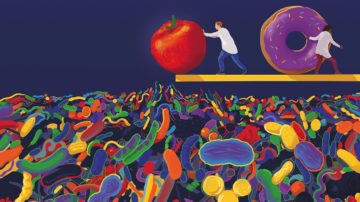Veronique Greenwood in Harvard Magazine:
 IN THE LATE 2000s, Rachel Carmody was spending a lot of time counting calories. An anthropology graduate student at Harvard, she was studying whether cooking changed the number of calories the gut can extract from food. When humans invented cooking thousands of years ago, she and her advisor Richard Wrangham wondered, had they opened the door to a new source of energy?
IN THE LATE 2000s, Rachel Carmody was spending a lot of time counting calories. An anthropology graduate student at Harvard, she was studying whether cooking changed the number of calories the gut can extract from food. When humans invented cooking thousands of years ago, she and her advisor Richard Wrangham wondered, had they opened the door to a new source of energy?
To find out, she’d fed raw or cooked food to mice and humans. She’d checked on the food in mice as it traveled through the stomach, the small intestine, and the large intestine. She’d even recruited people whose colon, a portion of the large intestine, had been removed, to take samples from their ileostomy bags so she could see what the food was like. She compared the energy that went into their bodies with what came out. And she and Wrangham discovered something extraordinary.
Cooking dramatically increased the calories humans and mice got from food. Cooked meat yielded 10 to 15 percent more calories than raw. Cooked sweet potatoes were a whopping 30 percent more caloric than uncooked ones. Now, in her office in the Museum of Comparative Zoology, Carmody, an assistant professor of human evolutionary biology, recalls her hunt to understand why.
Here’s part of what she found: cooking jump-starts digestion. With chemical bonds and cellular structures already broken down, it’s easier for digestive enzymes to make the energy in food available to an animal. But she could account for only a portion of the energy boost cooking produced. “I was panicking that my dissertation was going to be terrible,” she says. Something was missing.
More here.
